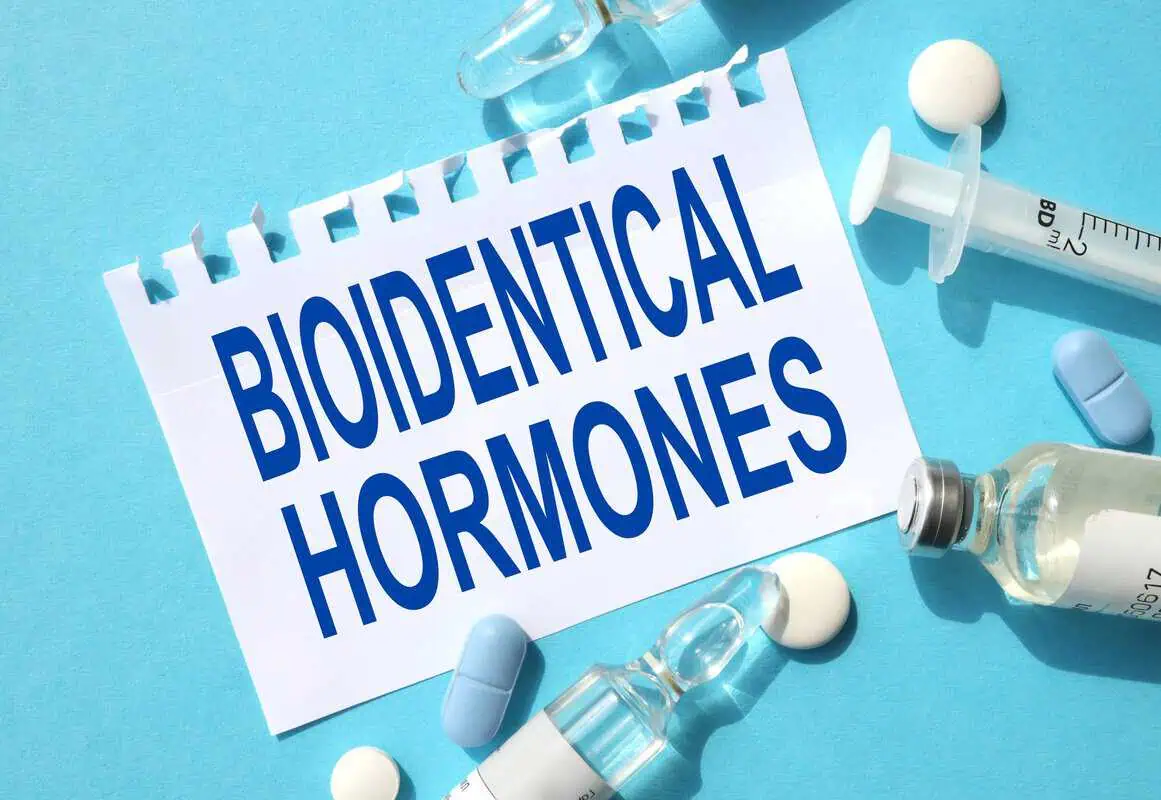
Female BHRT (Bioidentical Hormone Replacement Therapy) represents a significant advancement in addressing hormonal imbalances typically associated with menopause and aging. In order to provide a more natural approach to symptom relief, this customized treatment uses hormones that are biologically comparable to those the body naturally produces. BHRT has gained popularity for its potential to effectively manage a range of symptoms, from hot flashes to mood fluctuations, while aligning closely with each woman’s unique hormonal needs.
What are Bioidentical Hormones?
The purpose of bioidentical hormones is to replicate the body’s natural production of estrogen, progesterone, and occasionally testosterone. They are often derived from plant estrogens and are custom-compounded for each individual. This personalized approach is one of the key attractions of BHT.
Assessing the Duration of Use
Assessing the duration of use for bioidentical hormone therapy (BHT) in women involves several key factors:
Symptom Relief and Quality of Life
Symptom relief is a primary goal of bioidentical hormone therapy (BHT), especially for women undergoing menopause. These symptoms, which include vaginal dryness, mood swings, and hot flashes, can have a significant impact on day-to-day functioning and general well-being. BHT seeks to alleviate these symptoms by restoring hormonal balance, thereby enhancing the quality of life, with its effectiveness and personalization being key to its continued use.
The impact of BHT on quality of life extends beyond symptom management, encompassing improvements in sleep, sexual health, bone density, and psychological well-being. These benefits are integral for women navigating the menopausal transition, where hormonal changes can affect various aspects of health. Ongoing assessments and a holistic approach are essential in balancing these benefits against potential risks, highlighting the role of BHT in overall health and well-being during menopause.
Individual Health Profile
The individual health profile plays a crucial role in determining the suitability and duration of bioidentical hormone therapy (BHT) for women. Key factors include a woman’s age, her overall health status, and her personal and family medical history. Critical are potential risk factors for conditions like breast cancer, cardiovascular diseases, and osteoporosis, which hormone levels and therapy can influence.
Likewise, the presence of pre-existing conditions such as liver disease, blood clotting disorders, or a history of stroke also significantly impacts decisions regarding BHT. These conditions can alter the risk-benefit balance of hormone therapy, necessitating a more cautious approach. Personalized treatment plans, therefore, must be developed with these individual health considerations in mind, ensuring that BHT is both safe and effective for each woman.
Age and Menopause Timing
The timing of menopause and a woman’s age are critical factors in determining the appropriateness and duration of bioidentical hormone therapy (BHT). The ‘window of opportunity’ hypothesis suggests that BHT is most beneficial and poses the least risk if started around the time of menopause onset. Typically, this means beginning treatment within ten years of menopause or before a woman reaches the age of 60.
Moreover, the age at which menopause begins can influence the severity of symptoms and the body’s response to BHT. Women who experience early menopause may have different hormonal needs compared to those who undergo menopause at the average age. Hence, the timing of BHT initiation in relation to the onset of menopause is a key consideration in creating a personalized treatment plan that maximizes benefits and minimizes risks.
Balancing Risks and Benefits
Balancing the risks and benefits of bioidentical hormone therapy (BHT) is a critical aspect of managing menopause-related symptoms for women. While BHT can significantly alleviate symptoms like hot flashes and mood swings, it is not without potential risks, such as increased chances of blood clots, stroke, or certain types of cancer. Accordingly, it is important for healthcare providers to carefully evaluate each woman’s individual risk factors and health history before recommending BHT, ensuring that the benefits outweigh the potential risks.
This balance also involves continuous monitoring and reassessment throughout treatment. Women on BHT should undergo regular evaluations to monitor for any adverse effects and to assess the ongoing necessity and effectiveness of the therapy. Adjustments in dosage or therapy duration may be required based on these evaluations, highlighting the importance of a personalized and dynamic approach to BHT.
Lifestyle and Alternative Approaches
Lifestyle modifications and alternative approaches play a significant role in managing menopausal symptoms, offering a complementary or sometimes an alternative strategy to bioidentical hormone therapy (BHT). Dietary changes, regular physical activity, and stress reduction techniques can effectively alleviate some menopausal symptoms like mood swings, weight gain, and sleep disturbances. Similarly, women who choose not to use BHT or have contraindications may find that non-hormonal medicinal medications, such as gabapentin or selective serotonin reuptake inhibitors (SSRIs), are helpful in treating symptoms, including hot flashes and night sweats.
Herbal supplements and natural remedies are also popular among many women seeking to manage menopause symptoms. Phytoestrogens, found in foods like soy and herbs like black cohosh, have been used to mitigate symptoms, though their efficacy and safety vary. It is critical to discuss any alternative treatments with a healthcare professional because they may not be appropriate for all women and may mix with other medications. It emphasizes the necessity for a customized and knowledgeable approach to menopause management.
Guidelines and Recommendations
In order to reduce potential risks, guidelines and recommendations for bioidentical hormone treatment (BHT) emphasize the need for a cautious and individualized approach. They propose using the lowest effective dose for the shortest amount of time needed to relieve symptoms.
Regular monitoring and reassessment are essential, with women undergoing BHT requiring frequent check-ups for evaluating the therapy’s effectiveness and side effects and making necessary adjustments to the treatment plan, including dosage changes or discontinuation based on individual response and health changes. Informed consent is also a vital component, ensuring women are thoroughly educated by their healthcare providers about the potential benefits and risks of BHT, enabling them to make decisions that best suit their health goals and personal preferences.
Shortest Effective Duration
The principle of the shortest effective duration for bioidentical hormone therapy (BHT) centers on using the therapy for the minimum time necessary to manage symptoms effectively. By reducing the long-term dangers associated with prolonged hormone use, such as an increased risk of certain malignancies or cardiovascular problems, this method seeks to lessen symptoms of menopause, including hot flashes, mood swings, and sleep disruptions. The duration is tailored to each individual, regularly reviewed, and adjusted as needed, ensuring that the therapy is used only as long as it is beneficial and necessary for symptom management.
Regular Monitoring
Regular monitoring is a crucial aspect of bioidentical hormone therapy (BHT) management, ensuring both efficacy and safety for the patient. This process involves periodic check-ups with a healthcare provider to assess the patient’s response to the therapy, monitor for any side effects, and make necessary adjustments to the treatment regimen. These evaluations allow for ongoing personalization of the therapy, adapting to changes in the patient’s symptoms, health status, and needs, thereby optimizing the therapeutic outcomes while safeguarding against potential risks associated with hormone therapy.
Personalized Approach
A personalized approach in Female BHRT (Hormonal Hormone Reduction Therapy) is essential, recognizing that each woman’s experience with menopause and response to hormone therapy is unique. This strategy involves customizing the treatment plan based on the individual’s specific symptoms, health history, lifestyle factors, and personal preferences. By tailoring the type, dosage, and duration of hormones to the individual needs of each woman, healthcare providers can optimize the effectiveness of the therapy while minimizing potential risks, ensuring a more effective and safer treatment experience.
The Bottom Line
Bioidentical hormone therapy duration is individualized and requires ongoing dialogue with healthcare providers, allowing women to make informed decisions about their hormonal health as research evolves. Rose Med Miami provides Female Hormonal Hormone Reduction Therapy (BHRT) to help women overcome hormonal imbalances, improving their quality of life through bioidentical hormones. Contact us today and discover Female BHRT, a personalized medical approach that offers women targeted solutions for managing the complex challenges of hormonal imbalances during menopause and beyond.





